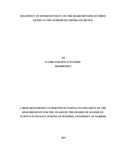| dc.description.abstract | The effects of dividend policy on share returns has remained an unsolved puzzle with different theories put forward giving compelling yet conflicting arguments. The research set out to determine the effect dividend policy has on share returns of companies listed at the Nairobi stock exchange. The study employed a descriptive research design. The population of the study consisted of all 65 organizations registered at the NSE. The sampling frame consisted of all actively trading companies that were listed at the NSE as at the end of 2015 and had had paid dividends in the preceding 5 years. During the study period there were 31 companies that had given out dividend, which formed the sample size of the study. This sample accounted for about 47.7% of the 65 listed companies at the NSE. The sampling period was 5 years from 1st January 2011 to 31st December, 2015. The research used quantitative secondary data. The data sources included all share return for NSE listed firms for the period in question, NSE handbook, and company’s annual reports for the study period. The study used the average returns throughout the year. This research employed inferential and descriptive statistics to analyze the data collected. This study established that although dividend payout ratio positively contributed to share returns for firms listed at NSE in 2011-2015 period, this contribution was not statistically significant. The same case applies to capital structure .Firm size had a positive relationship with share returns and this relationship was statistically significant and the same applied for inflation. Each year analyzed separately yielded different results with 2012 and 2013 showing that dividend payout ratio positively contributed to share returns. Capital structure was also found to positively contribute to share returns in 2012. Firm size was also found to positively predict dividend payout ratio for 2011-2015 period. Based on the findings, this study concludes that since dividend payout ratio has a positive contribution to share returns for listed firms at the NSE, it can be used to increase value of a firm. The study also concludes that since capital structure (debt to equity ratio) and firm size have positive contribution to share returns for firms listed at the NSE, they can be used to leverage the stock prices. Cross-sectional and longitudinal data show different results for dividend payout ratio and capital structure. Firm size can be used to predict dividend payout ratio and by extension share returns for firms listed at the NSE. This shows that large firms are likely to have high stock prices than their smaller or medium counterparts. This study having shown the association between share returns and dividend payout ratio, recommends that management and board of directors should adopt the appropriate dividend policies so as to satisfy shareholder goal of maximizing their return. The study also recommends that investors and investment analysts should take advantage of positive contribution of dividend payout ratio and its effect on the shares prices of firms listed on the NSE to make informed investment choices. Further research should cover a longer period to establish effects of dividend payout on share returns for firms listed at the NSE. | en_US |



